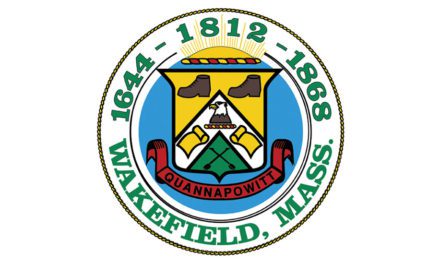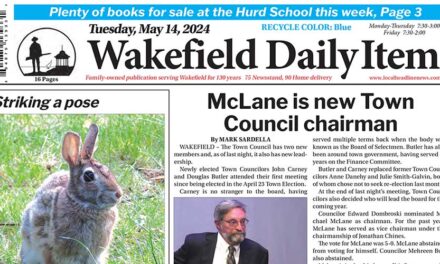Published in the September 11, 2017 edition
WAKEFIELD — Tonight the selectmen will be asked to adopt a Complete Streets program for the town.
In a memo to Town Administrator Stephen P. Maio, Town Planner Paul Reavis and DPW Director Richard Stinson write that Complete Streets is a key part of an assessment of what Wakefield’s downtown needs to become as vibrant as it can be.
“A major take-away from the 2016 Downtown Wakefield Market Assessment Report was the necessity of maintaining our efforts to obtain state funding for Main Street; streetscape improvements would encourage more activity and create a stronger community experience,” Stinson and Reavis begin.
They continue, “The earlier Main Street Corridor Study emphasized Wakefield’s tremendous mobility advantages: The residents of many neighborhoods live within a 20 minute walk to Main Street, a commuter rail station or bus stop.
“Walkability is highly desirable in planning a healthy community. Choosing to walk rather than drive is a real option for many Wakefield ‘s residents. A network of desirable landscaped walking routes to Main Street would enhance the whole town. A major step was taken in 2015 when Town Meeting voted to allow higher density developments within 2500 feet of our two commuter rail stations.
“Several projects are now under construction or being planned.
“Initiating the Albion Arts Corridor was a second effort to make Wakefield’s downtown a community experience. Leveraging a few arts-related business and using the former Light Department building as an arts center are arguably fledgling first steps to create a network of cultural venues and activity centers. To attract ‘creative-economy’ businesses to Albion Street a bricks-and-mmtar image change is needed. The town successfully obtained earmark funding in the 2014 Transpmtation Bond Bill; however, this state funding has yet to be released. The bond bill identified Albion Street as a Complete Streets project. Adopting the policy statement (accompanying this memo) could slightly improve our position to obtain the 2014 bond bill funding, but adoption would open additional funding opportunities. Of course, all activities will be coordinated with the overall branding direction for the town as contemplated by the Board of Selectmen.
“As an incentive to rethink the way towns plan and use their public right-of-ways, MassDOT (Massachusetts Depattment ofTranspottation) is offering $400,000 in construction funds to communities that advance through a series of training programs and policy changes. Both the Town Planner and Director of Public Works Director have attended the required Complete Streets training programs and learned of MassDOT’s new roadway design standards and MassDOT’s three tiered pledge, acceptance, and implementation program.”
What is a Complete Street?
Reavis and Stinson write, “There are many advocates for Complete Streets. The AARP’s Age Friendly Communities strategy embraces Complete Streets principles. Groups that promote cycling have been the strongest advocates. The American Planning Association published Complete Streets: Best Policy and Implementation Practices in 201 0; it is an extensive report promoting changes to the way streets are designed and built. The American Association of State Highway Transportation Officials (AASHTO) has revised the design manuals as well to reflect a shift from single-purpose-automobile only roadways to multi-user corridors. Universities granting degrees in transpmiation engineering have restructured their curricula around Complete Streets policies.
“The webpage of a non-profit, Smart Growth America, has one of the best explanations of Complete Streets: ‘For decades, the fields oftranspmiation planning and design focused on moving ablebodied adults in automobiles, creating a system that provides reasonably good mobility and convenience for millions of Americans. However, the needs of travelers outside that group, including younger or older people, those with disabilities, and those who travel by transit, bicycle, or foot, have been routinely overlooked. Neighborhoods lack safe places to walk or bicycle, and access to key community resources such as parks, shops, grocety stores, and schools is now dependent on access to an automobile. Thousands of people are injured or killed while walking or bicycling every year, in part due to the inhospitable built environment. Buses move down streets slowly and drivers — when not speeding along neighborhood streets are caught in traffic jams on major arterials.
“The Complete Streets movement aims to develop integrated, connected networks of streets that are safe and accessible for all people, regardless of age, ability, income, ethnicity, or chosen mode of travel. Complete Streets makes active transportation such as walking and bicycling convenient; provide increased access to employment centers, commerce, and educational institutions; and allow greater choice in traveling so that transpmiation doesn’t drain a family’s piggy bank.
“The term Complete Streets means much more than the physical changes to a community’s streets.
Complete Streets means changing transportation planning, design, maintenance, and funding decisions. A Complete Streets policy ensures that, from the start, projects are planned and designed to meet the needs of every community member, regardless of their age, ability, or how they travel.
Doing so allows a community to save money, accommodate more people, and create an environment where every resident can travel safely and conveniently.
“Complete Streets can be achieved through a variety of policies: ordinances and resolutions; rewrites of design manuals; inclusion in comprehensive plans; internal policies developed by transportation agencies; executive orders from elected officials, such as Mayors or Governors; and policies developed by stakeholders from the community and agency staff that are formally adopted by an elected board of officials.”




